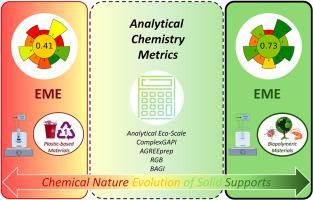当前位置:
X-MOL 学术
›
Anal. Chim. Acta
›
论文详情
Our official English website, www.x-mol.net, welcomes your feedback! (Note: you will need to create a separate account there.)
Chemical nature evolution of solid supports used in electromembrane extraction procedures: A comparative analysis based on metric tools
Analytica Chimica Acta ( IF 5.7 ) Pub Date : 2024-06-15 , DOI: 10.1016/j.aca.2024.342868 Cristina Román-Hidalgo , Mercedes Villar-Navarro , María Jesús Martín-Valero , Germán López-Pérez
Analytica Chimica Acta ( IF 5.7 ) Pub Date : 2024-06-15 , DOI: 10.1016/j.aca.2024.342868 Cristina Román-Hidalgo , Mercedes Villar-Navarro , María Jesús Martín-Valero , Germán López-Pérez

|
In recent decades, green chemistry has been focusing on the adaptation of different chemical methods towards environmental friendliness. Sample preparation procedures, which constitute a fundamental step in analytical methodology, have also been modified and implemented in this direction. In particular, electromembrane extraction (EME) procedures, which have traditionally used plastic supports, have been optimized towards greener approaches through the emergence of alternative materials. In this regard, biopolymer-based membranes (such as agarose or chitosan) have become versatile and very promising substitutes to perform these processes. Different green metric tools (Analytical Eco-Scale, ComplexGAPI and AGREEprep have been applied to study the evolution of solid supports used in EME from nanostructured tissues and polymer inclusion membranes to agar films and chitosan flat membranes. The main goal is to evaluate the usage of these new biomaterials in the analytical procedure to quantify their environmental impact in the frame of Green Analytical Chemistry (GAC). In addition, both RGB model and BAGI metrics have been employed to study the sustainability of the whole procedure, including not only greenness, but also analytical performance and feasibility aspects. Results obtained after the performance of the mentioned metrics have demonstrated that the most efficient and environmentally friendly analytical methods are based on the use of chitosan supports. This improvement is mainly due to the chemical nature of this biopolymer as well as to the removal of organic solvents. This work highlights the advantages of biodegradable materials employment in EME procedures to achieve green analytical methodologies. These materials also contribute to raise the figure of merits regarding to the quantification parameters in a wide range of applications compared to classical supports employed in EME, thus enhancing sustainability of procedures.
中文翻译:

电膜萃取过程中使用的固体支持物的化学性质演变:基于公制工具的比较分析
近几十年来,绿色化学一直致力于不同化学方法对环境友好的适应。样品制备程序是分析方法学的基本步骤,也已朝这个方向进行了修改和实施。特别是,传统上使用塑料支撑的电膜提取(EME)程序,通过替代材料的出现,已针对更环保的方法进行了优化。在这方面,基于生物聚合物的膜(例如琼脂糖或壳聚糖)已成为执行这些过程的多功能且非常有前途的替代品。不同的绿色度量工具(Analytical Eco-Scale、ComplexGAPI 和 AGREEprep)已用于研究 EME 中使用的固体支持物从纳米结构组织和聚合物包合物膜到琼脂膜和壳聚糖平板膜的演变。主要目标是评估这些新的生物材料在绿色分析化学(GAC)框架下量化其对环境的影响。此外,RGB模型和BAGI指标已被用来研究整个过程的可持续性,不仅包括绿色性,还包括绿色性。分析性能和可行性方面。上述指标的性能表明,最有效和环境友好的分析方法是基于使用壳聚糖载体,这种改进也主要归因于这种生物聚合物的化学性质。关于有机溶剂的去除,这项工作强调了在 EME 程序中使用可生物降解材料以实现绿色分析方法的优势。 与 EME 中使用的经典支持相比,这些材料还有助于提高各种应用中量化参数的品质因数,从而增强程序的可持续性。
更新日期:2024-06-15
中文翻译:

电膜萃取过程中使用的固体支持物的化学性质演变:基于公制工具的比较分析
近几十年来,绿色化学一直致力于不同化学方法对环境友好的适应。样品制备程序是分析方法学的基本步骤,也已朝这个方向进行了修改和实施。特别是,传统上使用塑料支撑的电膜提取(EME)程序,通过替代材料的出现,已针对更环保的方法进行了优化。在这方面,基于生物聚合物的膜(例如琼脂糖或壳聚糖)已成为执行这些过程的多功能且非常有前途的替代品。不同的绿色度量工具(Analytical Eco-Scale、ComplexGAPI 和 AGREEprep)已用于研究 EME 中使用的固体支持物从纳米结构组织和聚合物包合物膜到琼脂膜和壳聚糖平板膜的演变。主要目标是评估这些新的生物材料在绿色分析化学(GAC)框架下量化其对环境的影响。此外,RGB模型和BAGI指标已被用来研究整个过程的可持续性,不仅包括绿色性,还包括绿色性。分析性能和可行性方面。上述指标的性能表明,最有效和环境友好的分析方法是基于使用壳聚糖载体,这种改进也主要归因于这种生物聚合物的化学性质。关于有机溶剂的去除,这项工作强调了在 EME 程序中使用可生物降解材料以实现绿色分析方法的优势。 与 EME 中使用的经典支持相比,这些材料还有助于提高各种应用中量化参数的品质因数,从而增强程序的可持续性。






































 京公网安备 11010802027423号
京公网安备 11010802027423号